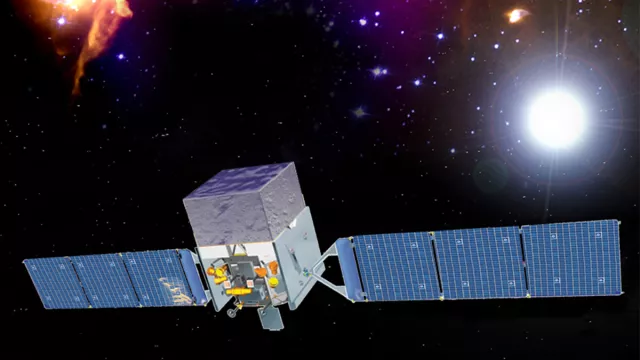Many objects in the universe, like dying stars or active galactic nuclei, emit gamma rays. The Fermi space telescope’s mission is to study this type of radiation, offering greater sensitivity to reveal previously unexplored regions.
Key information
Key figures
- 4,303 kg: satellite mass
- 5 keV to 300 GeV: energy range of detectable gamma rays
- 2.8 x 2.5 x 2.5 m: satellite dimensions
- 3 hrs: time taken to survey full sky
Key milestones
- 2019: NASA extends mission
- August 2013: NASA extends mission by five years
- 26 August 2008: GLAST telescope renamed Fermi
- 11 June 2008: Launch of GLAST telescope by Delta II
Project in brief
The Fermi Gamma-ray Space Telescope (FGST)—formerly the Gamma-ray Large Area Space Telescope (GLAST)—is an international project initiated by NASA in partnership with French, German, Italian, Japanese and Swedish research laboratories. The telescope is designed to detect the extragalactic gamma-ray background (EGB) and gain new insights into the most energetic events in the universe. Fermi was launched on 11 June 2008 from Cape Canaveral, Florida, by a Delta II launch vehicle.
Gamma rays are generated by the most extreme phenomena in the cosmos, such as pulsars, i.e. exploding dying stars, and galaxies hosting supermassive black holes. With its Gamma-ray Burst Monitor (GBM) and new-generation Large Area Telescope (LAT), Fermi has already detected a thousand sources including galactic core jets, young pulsars and millisecond pulsars, gamma-ray binaries and supernova remnants.
CNES’s role
This space mission is funded by NASA and the U.S. Department of Energy (DoE), with contributions from numerous laboratories. In France, the LP2IB physics of the two infinities laboratory, Bordeaux (ex-Centre d’Études Nucléaires de Bordeaux-Gradignan, CENBG), the LLR (Laboratoire Leprince-Ringuet) at the Ecole Polytechnique engineering school, the LUPM universe and particles laboratory in Montpellier and the Astrophysics department at the French atomic energy and alternative energies commission (CEA/Dap) in Saclay are taking part in the mission, with support from CNES.
Contacts
Head of Astronomy & Astrophysics
Philippe Laudet
E-mail: philippe.laudet at cnes.fr


